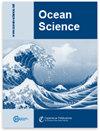Origins of mesoscale mixed-layer depth variability in the Southern Ocean
IF 3.3
3区 地球科学
Q2 METEOROLOGY & ATMOSPHERIC SCIENCES
引用次数: 0
Abstract
Abstract. Mixed-layer depth (MLD) exhibits significant variability, which is important for atmosphere–ocean exchanges of heat and atmospheric gases. The origins of the mesoscale MLD variability in the Southern Ocean are studied here in an idealised regional ocean–atmosphere model (ROAM). The main conclusion from the analysis of the upper-ocean buoyancy budget is that, while the atmospheric forcing and oceanic vertical mixing, on average, induce the mesoscale variability of MLD, the three-dimensional oceanic advection of buoyancy counteracts and partially balances these atmosphere-induced vertical processes. The relative importance of advection changes with both season and average MLD. From January to May, when the mixed layer is shallow, the atmospheric forcing and oceanic mixing are the most important processes, with the advection playing a secondary role. From June to December, when the mixed layer is deep, both atmospheric forcing and oceanic advection are equally important in driving the MLD variability. Importantly, buoyancy advection by mesoscale ocean current anomalies can lead to both local shoaling and deepening of the mixed layer. The role of the atmospheric forcing is then directly addressed by two sensitivity experiments in which the mesoscale variability is removed from the atmosphere–ocean heat and momentum fluxes. The findings confirm that mesoscale atmospheric forcing predominantly controls MLD variability in summer and that intrinsic oceanic variability and surface forcing are equally important in winter. As a result, MLD variance increases when mesoscale anomalies in atmospheric fluxes are removed in winter, and oceanic advection becomes a dominant player in the buoyancy budget. This study highlights the importance of oceanic advection and intrinsic ocean dynamics in driving mesoscale MLD variability and underscores the importance of MLD in modulating the effects of advection on upper-ocean dynamics.南大洋中尺度混合层深度变率的起源
摘要混合层深度(MLD)表现出显著的变率,这对大气和海洋之间的热和大气气体交换具有重要意义。本文在一个理想的区域海洋-大气模式(ROAM)中研究了南大洋中尺度MLD变率的起源。海洋上层浮力收支分析的主要结论是,大气强迫和海洋垂直混合平均诱导了MLD的中尺度变率,而海洋三维浮力平流抵消并部分平衡了这些大气诱导的垂直过程。平流的相对重要性随季节和平均MLD的变化而变化。1 ~ 5月,当混合层较浅时,大气强迫和海洋混合是最重要的过程,平流次之。6 - 12月混合层较深时,大气强迫和海洋平流对MLD变率的影响同等重要。重要的是,由中尺度海流异常引起的浮力平流可以导致混合层的局部浅化和加深。然后,大气强迫的作用由两个敏感性实验直接解决,其中从大气-海洋热通量和动量通量中去除中尺度变率。研究结果证实,夏季中尺度大气强迫主要控制MLD变率,冬季海洋内在变率和地面强迫同样重要。结果表明,冬季去除大气通量中尺度异常后,MLD方差增大,海洋平流成为浮力收支的主导因素。本研究强调了海洋平流和内在海洋动力在驱动中尺度MLD变率中的重要性,并强调了MLD在调节平流对上层海洋动力的影响中的重要性。
本文章由计算机程序翻译,如有差异,请以英文原文为准。
求助全文
约1分钟内获得全文
求助全文
来源期刊

Ocean Science
地学-海洋学
CiteScore
5.90
自引率
6.20%
发文量
78
审稿时长
6-12 weeks
期刊介绍:
Ocean Science (OS) is a not-for-profit international open-access scientific journal dedicated to the publication and discussion of research articles, short communications, and review papers on all aspects of ocean science: experimental, theoretical, and laboratory. The primary objective is to publish a very high-quality scientific journal with free Internet-based access for researchers and other interested people throughout the world.
Electronic submission of articles is used to keep publication costs to a minimum. The costs will be covered by a moderate per-page charge paid by the authors. The peer-review process also makes use of the Internet. It includes an 8-week online discussion period with the original submitted manuscript and all comments. If accepted, the final revised paper will be published online.
Ocean Science covers the following fields: ocean physics (i.e. ocean structure, circulation, tides, and internal waves); ocean chemistry; biological oceanography; air–sea interactions; ocean models – physical, chemical, biological, and biochemical; coastal and shelf edge processes; paleooceanography.
 求助内容:
求助内容: 应助结果提醒方式:
应助结果提醒方式:


